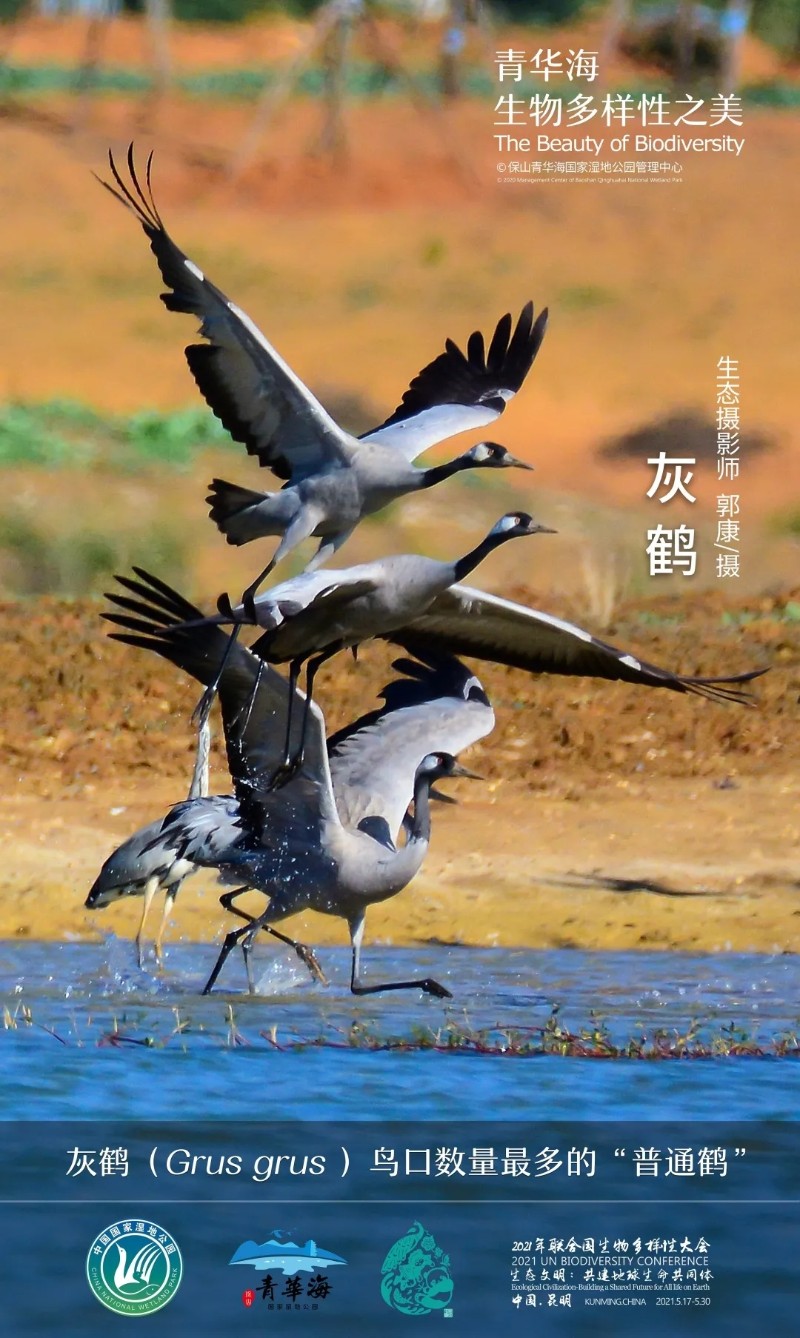【青华海生物多样性之美】灰鹤:鸟口数量最多的“普通鹤”

保山青华海国家湿地公园管理中心
保山市科学技术协会
联合推出
第5期
The 5th Phase
脊椎动物.灰鹤Grus grus
脊椎动物,鸟纲,鹤形目,鹤科。我国II级重点保护野生动物,主要分布在欧亚大陆,是典型的迁徙鸟类。每年10月,灰鹤从繁殖地开始迁徙,去往越冬地,并于次年3月返回繁殖地。在云南为冬候鸟或迁徙过境鸟。我国是鹤类种数最多的国家,全世界有15种鹤,而我国有9种。图片摄于云南保山青华海国家湿地公园。
灰鹤身材高挑,身高能达1.2米左右,喙长、颈长、腿长,是典型的“涉禽”。鸟如其名,全身的羽毛大部分为灰色。成年灰鹤具有黑白分明的头部,头顶黑色,中心红色(和亲戚丹顶鹤一样也有个小“丹顶”,这不是羽毛,而是充盈的血管在裸露的皮肤下呈现出来的红色,相当于有点“秃顶”),前颈黑色,自眼后有一道宽的白色条纹伸至颈背。站立时,能看到它们的“尾部”羽毛又大又长,像鸵鸟一样,这其实是灰鹤的三级飞羽。灰鹤雌雄差别不大,但成鸟和幼鸟形态差异显著,幼鸟的头部和颈部都是灰色的。
灰鹤的英文名为common crane,直译成中文为“普通鹤”,之所以普通,大概是因为它们分布广,较为常见。在世界范围内,灰鹤分布地包括了欧洲、亚洲和非洲。在我国,灰鹤分布于各省区,夏季主要在新疆、黑龙江、内蒙古等中高纬度地区繁殖,冬季则南迁至华中、华北、西南等地区越冬,越冬地十分广阔。在云南发现的灰鹤是从哪里来的呢?大概迁徙路线是从俄罗斯的西西伯利亚,经过新疆、甘肃、四川进入云南,部分留在云南越冬,另一部分稍作整顿之后,再往南进入缅甸和印度等地越冬。灰鹤能够适应多种环境而且生命力顽强,是目前世界上15种鹤中数量最大、分布最广的物种,全球种群数量在50万只左右。
灰鹤的越冬地通常会选择在开阔的平原、草地、沼泽、河滩、湖泊及农田地带。主要以植物的根、茎、叶、种子为食,喜欢吃豆类、玉米、马铃薯和冬小麦等作物以及湿地植物的种子或植株,偶尔也吃螺、鱼、虾等动物。灰鹤多集群越冬,觅食、警戒、休息、理羽是它们最主要的活动。无论在夜间还是白天,灰鹤群中都有“值班警卫鹤”及时报警,这样能够减少个体警戒的时间,能够有更多的时间花在觅食和补充能量上。
灰鹤喜欢集大群迁徙,迁徙的时候飞得很高,常常排列成“人”字形。身体保持水平,头、颈和细长的腿都伸得笔直,姿势从容优雅,振翅和滑翔过程十分缓慢而富有震撼力。灰鹤在飞行中常常发出深沉而嘹亮的叫声(类似于“karr”),起到联络呼叫的作用。《诗经.小雅.鹤鸣》就有“鹤鸣于九皋,声闻于野”之句。今年11月初,多个灰鹤群从保山上空经过,起码有2次分别是200多个的灰鹤大群,其中11月2日中午经过青华海东湖上空的200多只灰鹤,据说当天下午就到达了德宏,可能要飞往更南的地方越冬,很多市民都看到了这个壮观的场景。
鹤类对栖息环境要求较高,种群很容易受到威胁,需要加强保护。“清响彻云霄,万籁悉以屏”,愿年年能听到迁徙的鹤鸣,不只为天空那美丽的风景,也为了维护地球脆弱的生态平衡。
The 5th Phase
Common Crane(Grus grus)
Vertebrates, Aves, Gruiformes, Gruidae, is one of the ClassⅡnational key protected wild bird which mainly distributed in Eurasia, and is a typical migratory bird. Every October, Common Crane start their migration from their breeding places to the wintering habitat, then return back next March. In Yunnan province, they are winter residents or migratory birds. China is the richest in variety of crane species. There are 15 kinds of cranes in the world, while there are 9 kinds in our country. The photo is taken in The Qinghuahai National Wetland Park in Baoshan city, Yunnan proince.
Common Crane is tall, reaching a height of about 1.2 meters, with long beak, neck and legs. They are typical "waders". As the name suggests, Common Crane are mostly gray in feathers. Adults have black and white head, and the top of the head is black with a red spot in the middle (just like their relative Red-crowned Crane, this red spot is not feather, but the blood vessels under the bare skin, which appears red and like a little "bald"). The foredeck is black and there is a wide white stripes from the eyes to the nape of the neck. When standing, you can see their large and long "tail" feathers, like ostriches, which are actually the tertiaries. There is little difference between males and females, but there is a significant difference between adult birds and young. The young birds have gray heads and necks.
Why Grus grus was called Common Crane, probably because it is widely distributed and relatively common. You can see Common Crane in Europe, Asia and Africa. In China, Common Crane are distributed in all provinces and regions. In summer, they mainly breed in mid-and high-latitude areas such as Xinjiang, Heilongjiang and Inner Mongolia. In winter, they migrate south to central China, North China, southwest China and other regions, and their wintering areas are very broad. Where did the cranes found in Yunnan come from? Their probable migration route is from Russia's western Siberia through Xinjiang, Gansu and Sichuan into Yunnan, some remaining in Yunnan for wintering, others heading south into Myanmar and India for wintering after a short break. Common Crane are able to adapt to a variety of environments and are hardy birds. They are the largest and most widely distributed of the 15 species of cranes in the world. The global population is estimated to number 500,000 individuals.
The wintering grounds of Common Crane are usually open plains, grasslands, swamps, rivers, lakes and farmland. They mainly eat roots, stems, leaves and seeds of plants. They like to eat beans, corn, potatoes, winter wheat and other crops, as well as seeds or plants of wetland plants. Occasionally, they also eat animals such snails, fish and shrimps. Many Common Crane overwinter in clusters. Foraging, warning, resting and preening are their most important activities. The guard cranes are on duty day and night, which allows other cranes spend more time foraging.
Common Crane like to migrate in large groups. They fly very high, and often arrange in a "V" shape. They keep their body level, and straighten their head, neck and legs, which makes their posture poised and graceful. Their wing flapping and gliding was slow and impressive. In flight, the crane often emits a deep and loud call (similar to "Karr"), which serves as a liaison. The Book of Songs described similar scenes . In early November this year, several Common Crane groups pass over Baoshan city, and there are at least 2 large groups over 200 Common Cranes. A group of Common Crane was seen passing over Qinghuahai at noon in November 2. It is said that they have arrived in Dehong in the afternoon that day, and they probably fly further south to overwintering. Many citizens have seen the spectacular scenes.
Cranes have a high demand on the habitat environment, and is easily threatened, which needs strengthen the protection. We hope to see the migrating cranes every year, not only for the beautiful scenery in the sky, but also for the weak ecological balance of the earth.
摄影师介绍
Introduction of the photographer

郭康,云南省保山市隆阳区人,生态摄影师,有5年的鸟类摄影经验。保护鸟类,保护野生动物,维护生态平衡。
GuoKang, a native of Longyang District, Baoshan City, Yunnan Province, is an experienced ecological photographer about 5 years in bird photography. Protect birds, protect wild animals and keep ecological balance.
文字整理:黄木娇
海报设计:黄木娇
英文翻译:何雪、黄木娇
Text: Mujiao Huang
Poster design: Mujiao Huang
English translation: He Xue, Mujiao Huang
精彩推荐
| 我也说两句 |
| 版权声明: 1.依据《服务条款》,本网页发布的原创作品,版权归发布者(即注册用户)所有;本网页发布的转载作品,由发布者按照互联网精神进行分享,遵守相关法律法规,无商业获利行为,无版权纠纷。 2.本网页是第三方信息存储空间,阿酷公司是网络服务提供者,服务对象为注册用户。该项服务免费,阿酷公司不向注册用户收取任何费用。 名称:阿酷(北京)科技发展有限公司 联系人:李女士,QQ468780427 网络地址:www.arkoo.com 3.本网页参与各方的所有行为,完全遵守《信息网络传播权保护条例》。如有侵权行为,请权利人通知阿酷公司,阿酷公司将根据本条例第二十二条规定删除侵权作品。 |
